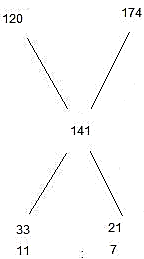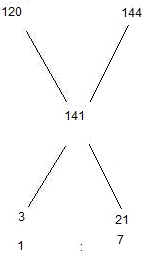Exams > Cat > Quantitaitve Aptitude
BASIC ARITHMETIC MCQs
Total Questions : 150
| Page 5 of 15 pages
Answer: Option E. -> Rs. 62985.6
:
E
Deepak was getting 10% interest, 20% of the interest i.e. 20% of 10% (=2%) was the tax which he had to pay, so the net interest rate (after tax) =10−2=8%
So, amount received by him after 3 years =50000(1+(8100))3=Rs.62985.6
Hence option (5)
2nd method:-By, pascal triangles for n=3&r=8%. Option (5).
:
E
Deepak was getting 10% interest, 20% of the interest i.e. 20% of 10% (=2%) was the tax which he had to pay, so the net interest rate (after tax) =10−2=8%
So, amount received by him after 3 years =50000(1+(8100))3=Rs.62985.6
Hence option (5)
2nd method:-By, pascal triangles for n=3&r=8%. Option (5).
Answer: Option A. -> Rs. 5760
:
A
Let the value of each installment is X, Total amount is P
P=X(K+K2+K3+...................),WhereK=100100+r Here only two years and r is 10% then
P=X(K+K2)
10000=x{1011+(1011)2}
X = 5761.9
Alternatively
10,000(1.1)2=x[1+(1.1)]
x = 5761.9
:
A
Let the value of each installment is X, Total amount is P
P=X(K+K2+K3+...................),WhereK=100100+r Here only two years and r is 10% then
P=X(K+K2)
10000=x{1011+(1011)2}
X = 5761.9
Alternatively
10,000(1.1)2=x[1+(1.1)]
x = 5761.9
Answer: Option C. -> 11: 77: 7
:
C
First mix varieties A&C in a ratio to get a mixture at the cost Rs. 141 per litre.
Applying Alligation:

Now mix varieties A&B to get a mixture at the cost of Rs. 141 per litre.

So, A: C in ratio 11: 7 and A: B in ratio 1: 7.The required ratio A: B: C = 11: 77: 7. Hence option (c).
2nd method:- By, observation, 141 is nearest to B (144) then A(120) and then C(174). When we mix all three then highest contribution will be according the above, i.e B→A→C , Now only option (c).
:
C
First mix varieties A&C in a ratio to get a mixture at the cost Rs. 141 per litre.
Applying Alligation:

Now mix varieties A&B to get a mixture at the cost of Rs. 141 per litre.

So, A: C in ratio 11: 7 and A: B in ratio 1: 7.The required ratio A: B: C = 11: 77: 7. Hence option (c).
2nd method:- By, observation, 141 is nearest to B (144) then A(120) and then C(174). When we mix all three then highest contribution will be according the above, i.e B→A→C , Now only option (c).
:
In 1 day 4 men and 2 boys can do [100(203)]%=15% of the job. ... (i)
In 1 day 3 women and 4 boys can do 1005=20%of the job.... (ii)
In 1 day 2 men and 3 women can do 1004=25%of the job.... (iii)
So, adding (i), (ii), (iii)
6 men, 6 women and 6 boys can do 15 + 20 + 25 = 60% of the job in 1 day.
So, 1 man, 1 woman and 1 boys can do 10% of the job in a day.
All double their efficiency, they can do 20% of the job in a day.
They can complete the job in 10020= 5 days.
Answer: Option A. -> 6(23) days
:
A
A can finish the work in 12 days.
He can finish 100% of the work in 12 days.
In 1 day he can finish (10012)%=8.33%of the work.
Similarly B can finish (10015)%=6.67% of the work in 1 day.
When they both work together, they can finish (8.33+6.67)%=15% of the work in 1 day
So, to complete 100% of the work, they will take (10015)e=6(23) days. Hence option (a).
2nd method:-Total work (W) = 12A = 15B , B=45A
n(A+B) = W = 12A or 15B (Here, we take 12A).
n(A+B)=12A,n(A+45A),n=203=6(23)days. Option (a).
:
A
A can finish the work in 12 days.
He can finish 100% of the work in 12 days.
In 1 day he can finish (10012)%=8.33%of the work.
Similarly B can finish (10015)%=6.67% of the work in 1 day.
When they both work together, they can finish (8.33+6.67)%=15% of the work in 1 day
So, to complete 100% of the work, they will take (10015)e=6(23) days. Hence option (a).
2nd method:-Total work (W) = 12A = 15B , B=45A
n(A+B) = W = 12A or 15B (Here, we take 12A).
n(A+B)=12A,n(A+45A),n=203=6(23)days. Option (a).
Answer: Option B. -> 15 ltr
:
B
After these two transfers = milk is left in the container in ratio 9: 25
(k−6)2k2=925k=15.
Hence option (b)
:
B
After these two transfers = milk is left in the container in ratio 9: 25
(k−6)2k2=925k=15.
Hence option (b)
:
A can finish the work in 16 days. In one day he can finish (10016)%of the work.
In 4 days, working alone he will finish [(10016)×4]=25% of the work.
Now B joins him.
Amount of work left = 100 – 25 = 75%
B can do (1008)% of the work.
A and B together can do (1008)%+(10016)%=(30016)%of the work.
Work left =75% . Hence time taken =[(75×16)300]=4days.
So, total time taken = 4 + 4 = 8 days.
2nd method:- In 4 days A will finish 25% of work. Remaining work is 75%, Efficiency of B is double than A i.e 50% work will done by B and 25% will done by A. Thus it will take 4 days. Total 8 days.
Answer: Option C. -> 203 days
:
C
Suppose Ajit can finish the work in ‘x’ days. In one day he can do (100x)%of the work.
As Ajit is thrice as good as Dev, Dev will do 13rdof what Ajit can do in a day.
So, Dev can do (1003x)%of work in a day.
Now they complete the work in 5 days, so in 1 day they must be doing 1005=20%of the work.
So, (100x)+(1003x)=20
x=(203)
So, Ajit can complete the work alone in (203) days. Hence option (d).
2nd method:- Efficiency A=3D,5(A+D)=nA(i.e.,)5×43A=nA,n=203days.
:
C
Suppose Ajit can finish the work in ‘x’ days. In one day he can do (100x)%of the work.
As Ajit is thrice as good as Dev, Dev will do 13rdof what Ajit can do in a day.
So, Dev can do (1003x)%of work in a day.
Now they complete the work in 5 days, so in 1 day they must be doing 1005=20%of the work.
So, (100x)+(1003x)=20
x=(203)
So, Ajit can complete the work alone in (203) days. Hence option (d).
2nd method:- Efficiency A=3D,5(A+D)=nA(i.e.,)5×43A=nA,n=203days.
Answer: Option C. -> 20
:
C
Pipe A can fill a tank completely in 4 hours, Thereforein 1 hour, it can fill 1004=25% of the tank.
Pipe B can empty the tank in 5 hours, Therefore in 1 hour, it can empty 1005=20% of the tank.
So, when both are simultaneously working, then in 1 hour 5% of the tank will be filled.
For filling the tank completely, it will take 1005 = 20 hours.
2nd method:- (14)−(15)=120 . Thus tank will fill in 20 days.
:
C
Pipe A can fill a tank completely in 4 hours, Thereforein 1 hour, it can fill 1004=25% of the tank.
Pipe B can empty the tank in 5 hours, Therefore in 1 hour, it can empty 1005=20% of the tank.
So, when both are simultaneously working, then in 1 hour 5% of the tank will be filled.
For filling the tank completely, it will take 1005 = 20 hours.
2nd method:- (14)−(15)=120 . Thus tank will fill in 20 days.
:
Let a, b and c be the % of the work done by A, B and C in one day respectively.
A&B can complete the work in 12 days a+b=10012%=8.33%...(i)
B&C can complete the work in 15 days b+c=10015%=6.67%....(ii)
A&C can complete the work in 20 days a+c=10020%=5%....(iii)
Adding (i), (ii) and (iii)
2(a+b+c)=20%⇒(a+b+c)=10%
So, working together they finish 10% of work in a day. So, they can complete the work in 10 days.
















